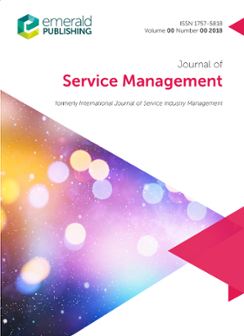The extended reality technology (ERT) framework for designing customer and service experiences in phygital settings: a service research agenda
IF 7.8
2区 管理学
Q1 MANAGEMENT
引用次数: 6
Abstract
PurposeBecause new-age technologies are gaining a broader interest among service scholars and practitioners, it is critical to identify these technologies and examine the roles they play. The examination needs to be conducted to design engaging customer and service experiences in new phygital settings that connect physical and digital environments. This review article aims to provide researchers with a new comprehensive and integrative extended reality technology (ERT) framework. The framework serves as the basis for an all-inclusive view of ERT types in order to explore the different types of technology used to design phygital customer and service experiences.Design/methodology/approachThis article reviews prior works on the role technology plays in terms of customer experiences across various fields of research, including consumer, marketing and service literature. Adopting an experiential and phygital perspective as well as considering a consumer standpoint, this article defines the scope of the ERT framework by identifying categories of new-age technologies and their effects related to the design of phygital customer and service experiences.FindingsThe ERT framework proposed in this article offers directions for future research by adopting an experiential approach to technologies in order to categorize additional technological devices, platforms and tools that can be considered in the design of phygital experiences following several extension processes. These processes can enhance the cognitive, social, sensory and contextual dimensions of the phygital experience and thus create a continuum in terms of customer value from physical to digital settings and vice versa.Research limitations/implicationsCompanies and service providers may benefit from a new, comprehensive, focused framework that assembles different types of technology. The technologies can be utilized to design engaging customer and service experiences that deliver customer value from physical to digital spaces and inversely.Originality/valueNo prior works have proposed a comprehensive ERT framework for service research following an experiential perspective and a consumer view of the experience occurring in a new setting: phygital. By embracing the ERT framework provided in this article, future service scholars can examine the dynamics and types of technologies that can positively or negatively affect the design of consumption and service experiences in phygital settings.在数字环境中设计顾客和服务体验的扩展现实技术(ERT)框架:一个服务研究议程
由于新时代技术在服务学者和从业者中获得了更广泛的兴趣,因此识别这些技术并研究它们所扮演的角色至关重要。在连接物理和数字环境的新物理环境中,需要进行检查以设计引人入胜的客户和服务体验。本文旨在为研究人员提供一个新的全面集成的扩展现实技术(ERT)框架。该框架作为ERT类型的全面视图的基础,以便探索用于设计物理客户和服务体验的不同类型的技术。设计/方法/方法本文回顾了以前关于技术在不同研究领域的客户体验方面所起作用的工作,包括消费者、营销和服务文献。本文采用体验和实体视角,并考虑到消费者的立场,通过确定新时代技术的类别及其与实体客户和服务体验设计相关的影响,定义了ERT框架的范围。本文提出的ERT框架通过采用经验方法对技术进行分类,为未来的研究提供了方向,这些技术设备、平台和工具可以在几个扩展过程后的物理体验设计中考虑。这些过程可以增强物理体验的认知、社会、感官和情境维度,从而在客户价值方面创造一个连续体,从物理环境到数字环境,反之亦然。研究局限/启示公司和服务提供商可能会从一个新的、全面的、集中的框架中受益,该框架汇集了不同类型的技术。这些技术可以用来设计引人入胜的客户和服务体验,将客户价值从物理空间传递到数字空间,或者反过来传递。原创性/价值我之前的作品提出了一个全面的服务研究ERT框架,它遵循经验视角和消费者对新环境中发生的体验的看法:物理。通过采用本文提供的ERT框架,未来的服务学者可以研究动态和技术类型,这些技术可以积极或消极地影响物理环境中消费和服务体验的设计。
本文章由计算机程序翻译,如有差异,请以英文原文为准。
求助全文
约1分钟内获得全文
求助全文
来源期刊

Journal of Service Management
MANAGEMENT-
CiteScore
19.20
自引率
9.40%
发文量
55
期刊介绍:
The Journal of Service Management (JOSM) centers its scope on research in service management. It disseminates papers showcasing distinctive and noteworthy contributions to service literature, serving as a communication platform for individuals in the service management field, transcending disciplines, functional areas, sectors, and nationalities. The journal publishes double-blind reviewed papers emphasizing service literature/theory and its practical applications.
 求助内容:
求助内容: 应助结果提醒方式:
应助结果提醒方式:


